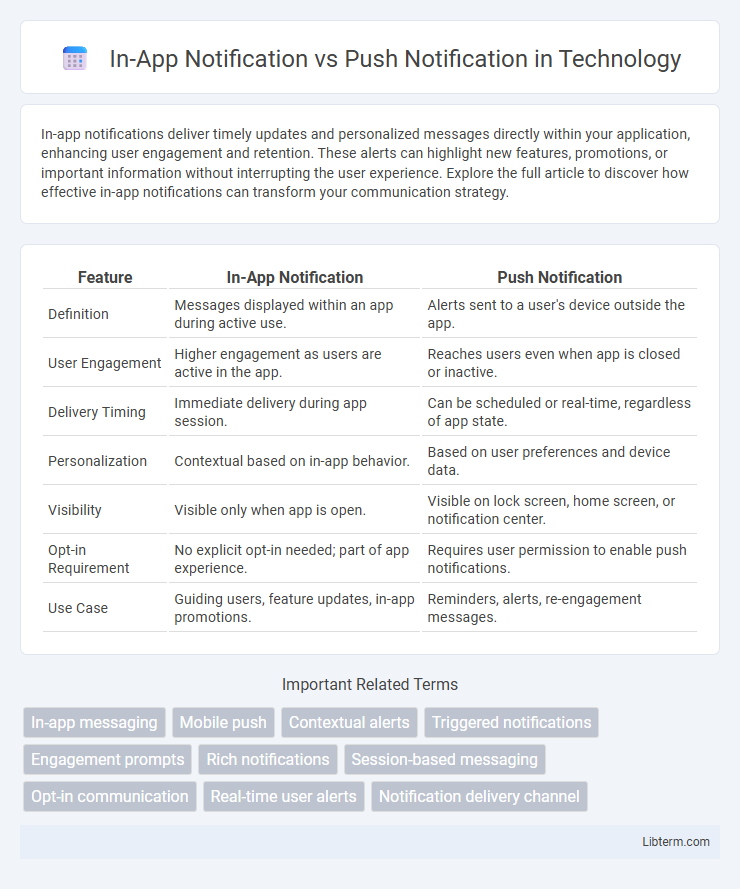In-app notifications deliver timely updates and personalized messages directly within your application, enhancing user engagement and retention. These alerts can highlight new features, promotions, or important information without interrupting the user experience. Explore the full article to discover how effective in-app notifications can transform your communication strategy.
Table of Comparison
| Feature | In-App Notification | Push Notification |
|---|---|---|
| Definition | Messages displayed within an app during active use. | Alerts sent to a user's device outside the app. |
| User Engagement | Higher engagement as users are active in the app. | Reaches users even when app is closed or inactive. |
| Delivery Timing | Immediate delivery during app session. | Can be scheduled or real-time, regardless of app state. |
| Personalization | Contextual based on in-app behavior. | Based on user preferences and device data. |
| Visibility | Visible only when app is open. | Visible on lock screen, home screen, or notification center. |
| Opt-in Requirement | No explicit opt-in needed; part of app experience. | Requires user permission to enable push notifications. |
| Use Case | Guiding users, feature updates, in-app promotions. | Reminders, alerts, re-engagement messages. |
Introduction to In-App and Push Notifications
In-app notifications are messages delivered within a mobile application while users are actively engaged, enabling real-time interaction and personalized content display. Push notifications, sent from servers to user devices even when the app is inactive, serve as external alerts to boost user re-engagement and retention. Both notification types play critical roles in mobile marketing strategies by enhancing user experience and driving app usage.
Defining In-App Notifications
In-app notifications are messages that appear directly within a mobile application while the user is actively engaged, delivering timely updates, alerts, or personalized content without redirecting the user away from the app experience. These notifications facilitate real-time interaction, enhance user engagement, and provide contextual information based on user behavior or app events. Unlike push notifications, in-app notifications require the app to be open and are customizable in design, positioning, and functionality to align with the app's user interface.
Defining Push Notifications
Push notifications are real-time messages sent directly to a user's device, even when the app is not open, designed to increase engagement and deliver timely information. These alerts appear on the lock screen or notification center, leveraging device-level permissions to ensure immediate visibility. Unlike in-app notifications, push notifications require explicit user consent and are typically used for urgent updates, promotions, or personalized reminders.
Key Differences Between In-App and Push Notifications
In-app notifications appear only when users are actively engaged within the app, providing context-specific messages tailored to their current actions, while push notifications reach users outside the app, delivering timely alerts and updates directly on their device home screens or lock screens. In-app notifications can enhance user experience by offering interactive content without interrupting, whereas push notifications are crucial for re-engagement, driving users back to the app through personalized offers or reminders. The effectiveness of push notifications depends on opt-in rates and timing, while in-app notifications rely heavily on real-time user behavior and session context.
Use Cases for In-App Notifications
In-app notifications are ideal for delivering contextual, real-time updates while users are actively engaged within the app, such as alerts about new features, promotions, or important account activities. They enhance user experience by providing timely information without interrupting the workflow, making them suitable for onboarding, personalized offers, and engagement-driven interactions. Unlike push notifications, in-app notifications require user presence in the app, ensuring higher relevance and immediate visibility in targeted use cases.
Use Cases for Push Notifications
Push notifications are essential for real-time alerts, such as breaking news updates, appointment reminders, and flash sale announcements, ensuring immediate user engagement. They excel in reaching users outside the app environment, making them ideal for re-engagement, personalized marketing campaigns, and time-sensitive promotions. Retail, media, and healthcare industries leverage push notifications to boost retention and drive instant actions based on user behavior.
Pros and Cons of In-App Notifications
In-app notifications offer immediate engagement by delivering relevant messages directly within the app interface, enhancing user experience without interrupting outside activities. They provide higher contextual relevance and increased interaction rates but are limited to users actively using the app, reducing reach compared to push notifications that appear even when the app is closed. The primary downside of in-app notifications is their inability to engage inactive users, making them less effective for re-engagement campaigns compared to push notifications designed for broader user retention.
Pros and Cons of Push Notifications
Push notifications offer immediate engagement by delivering timely alerts directly to a user's device, increasing app retention and real-time communication. However, they risk annoying users if overused, potentially leading to app uninstalls or notification disablement. Unlike in-app notifications, push notifications can reach users regardless of whether the app is open, but their dependence on user permission and platform restrictions limits reach and effectiveness.
Best Practices for Notification Strategy
Effective notification strategies prioritize timing, personalization, and relevance to enhance user engagement and retention. In-app notifications should be used for context-sensitive messages that enhance user experience during app interaction, while push notifications are ideal for re-engagement and timely updates even when users are inactive. Segmentation and A/B testing optimize delivery by targeting user preferences and behaviors, reducing notification fatigue and increasing conversion rates.
Choosing the Right Notification Type for Your App
In-app notifications engage users while they actively interact with your app, delivering contextual messages that enhance the user experience without disrupting their flow. Push notifications re-engage users even when the app is closed, driving retention through timely alerts and personalized offers. Selecting the right notification type depends on user behavior analysis and app goals, balancing immediacy with relevance to optimize user engagement and retention metrics.
In-App Notification Infographic

 libterm.com
libterm.com